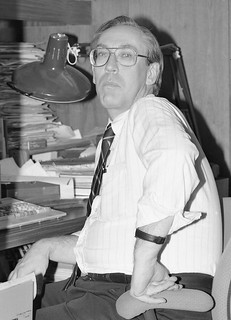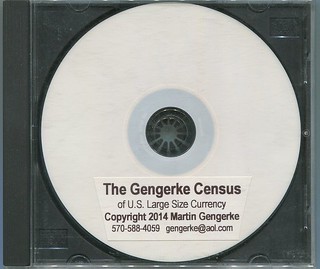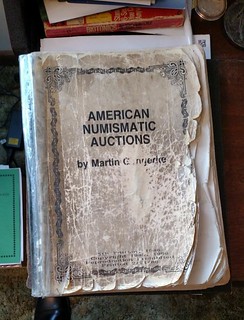
PREV ARTICLE
NEXT ARTICLE
FULL ISSUE
PREV FULL ISSUE
MORE ON MARTIN GENGERKEAnthony Terranova of New York City writes: "Greatly saddened to hear about my friend Martin. We will miss his wisdom." Mike Hodder submitted these notes on Martin and his impact on numismatic publishing and cataloging. Thanks! I added an image of Martin circa 1993 at his desk in the Coin Galleries office courtesy of George Cuhaj, who worked there from 1990 to mid-1994. -Editor
Martin was Stack’s computer maven. He had brought the firm into modern times by introducing into its cataloguing methods the software then being used by the NY Times. This was a word processing program named XyWrite III+ that ran on DOS (I think the flavour was MS-DOS). It was entirely keyboard driven requiring memorization of Control and Alt key combinations and the use of other unintuitive commands to indicate bold or Italic text. Martin loved the software; he once told me he thought a mouse was a lazy man’s input device. Stack’s cataloguing procedure at the time I started there was a combination of the traditional 1940’s-50’s method with hints of the technology to come that would revolutionize the whole thing. Descriptions were written by hand on the face of No.6 envelopes along with the consignor’s identification letter and a note of what sale the lot was to go into. The coin or medal, itself, was enclosed in the envelope to allow for later grade and attribution checks as needed. White envelopes were used for regular Stack’s floor bid sales, green ones for Coin Galleries’ mail bid sales. Martin and George transcribed the handwritten descriptions into XyWrite III+ and saved their work onto floppies at the end of the day. Martin’s job at cataloguing deadline was to arrange all the descriptions into agreed on sale order, control fonts and type sizes, and oversee the transfer of files from XyWrite III+ into the format used by the firm that printed and bound Stack’s catalogues. When I knew him, Martin seemed a very private person. His knowledge of fractional currency seemed formidable to me. His catalogue of American auction catalogues was one of the handful of reference works I always used in my work. A cryptic note on a consignor’s inventory like “Bt. at sale 5/81” would lead first to Martin’s list to see if an auction had taken place that month and then to identify the sale and company, then a visit to Stack’s comprehensive library to hunt down that sale catalogue, then to possible candidates for an identification and if I was lucky, a precise description or a plate of the coin to seal the provenance. I’ve sold or given away most of my numismatic library but I’ve hung onto my bound copy of Martin’s American Numismatic Auctions for old time’s sake.
Mike Hodder
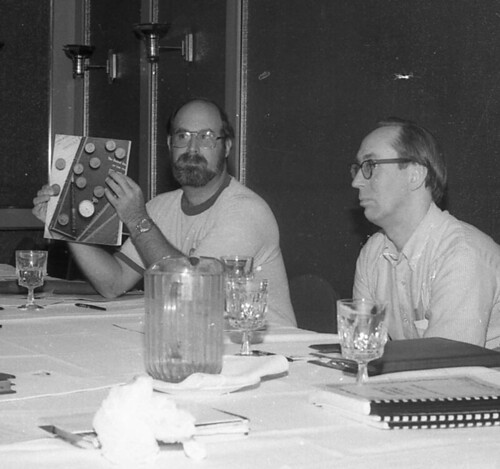
Peter Huntoon shared these thoughts on Martin and his impact on numismatics. Thank you! -Editor I knew Martin professionally primarily as one of the pioneers in maintaining a census of U. S. large size currency. I was aware that he had assembled and sold a world class collection of U. S. fractional currency. His ownership pedigrees on items in that collection will greatly outlive him, but in my opinion his census work ultimately will define his numismatic legacy. He recorded all classes of large size U. S. currency and was well advanced when I became aware of him in the 1970s. I don’t know what motivated him along this line, but it certainly made sense for someone working in the numismatic auction business because a census defines rarity, reveals available grades, and, for lore, records pedigrees. Martin compiled all these statistics and paid close attention to pedigrees. He enjoyed ferreting out first appearances of classic items in early major collections or sales, and he tracked items through successive appearances. Working for Stacks gave him access to significant holdings of key material, which was a major competitive advantage for him. However, Martin did not confine his quest to the numismatic market. He made a major effort to catalog institutional holdings including museums, libraries, governmental agencies, and commercial banks. He realized institutional holdings were where many major rarities were to be found. He got access to and painstakingly recorded the holdings of Federal Reserve Banks, various Treasury agencies, and the Smithsonian Institution. In the course of this work, he helped uncover unrecorded issues and previously unrecognized varieties. He partnered with noted Federal paper researcher Doug Murray in this effort and together they materially added to listings in the Friedberg catalog. The numbering system in the Friedberg catalog runs chronologically through the various classes of currency, so a new discovery of say a Treasury signature combination or design variety requires insertion, which involves adding a letter suffix to the existing number representing the previously recorded item in the list such as Fr.1166c. Many of the items listed in the Friedberg catalog followed by such a letter are the result of the Gengerke/Murray collaboration. To maintain a census, one must record everything. Martin digested auction catalogs as fast as they came along, a tedious, time-consuming task that grew burdensome and eventually overwhelming with the explosive growth of paper money collecting and sales in the last three decades of the 20th century. Eventually, he saw the writing on the wall and sought to divest himself of the particularly onerous burden of national bank notes so he could focus on the other Federal large size issues. Around the turn of the century, he negotiated the transfer of his large size national bank note census to Don Kelly, who by then had taken on the John Hickman census and thus had a national bank note census that was eclipsing Martins. Martin’s additions to the Hickman-Kelly census materially expanded the whole and that whole now comprises the core of the National Currency Census operated by Andrew Shiva of well over half a million notes.
It is my opinion that Martin’s enduring legacy in numismatics was his role in compiling his census and his devotion to tracing pedigrees during the 20th century. His monetary reward was nil for this activity, it was a true labor of love.
Peter Huntoon
Dave Hirt writes: "Martin did all of us literature collectors a big favor. The information he published never got out of date! It was just there waiting to be looked up!" 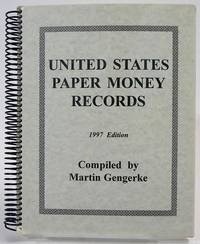
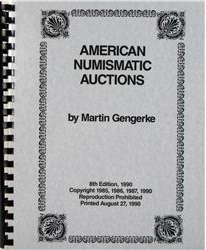
Martin has left an enduring legacy in not one, but TWO numismatic fields: U.S. Paper Money and U.S. Numismatic Literature. We are all better off today as a result of his monumental cataloging efforts. Here's a photo of Dave Hirt's shopworn copy of the Gengerke American Numismatic Auctions book. Thanks, Martin! -Editor
To read the earlier E-Sylum article, see:
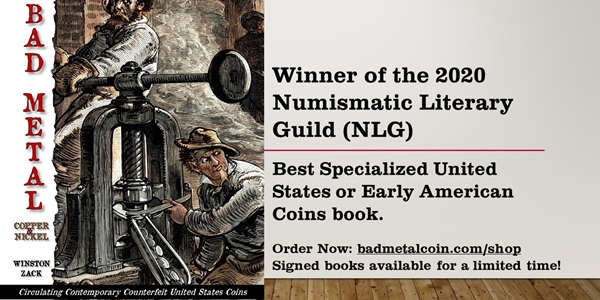
Wayne Homren, Editor The Numismatic Bibliomania Society is a non-profit organization promoting numismatic literature. See our web site at coinbooks.org. To submit items for publication in The E-Sylum, write to the Editor at this address: whomren@gmail.com To subscribe go to: https://my.binhost.com/lists/listinfo/esylum All Rights Reserved. NBS Home Page Contact the NBS webmaster 
|
